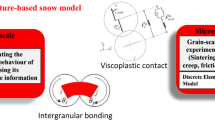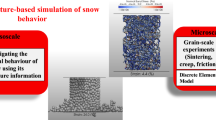Abstract
Snow material is an example of a geomaterial whose micro-structure plays a significant role in its overall constitutive behaviour. A snow sample can be regarded at the microscopic level as a cohesive granular assembly; the behaviour of ice bonds at the interface of each pair of grains in contact, which has a substantial influence on the overall behaviour, can be expressed in a straightforward manner. This paper derives the constitutive behaviour of the snowpack on the macroscopic level from a microscopic-scale description, taking into account a statistical description of the fabrics. In this approach, the location of each particle does not play a role, but the probability of a grain bond existing in a given direction is investigated. Modelling the creation or the failure of contacts in given directions makes it possible to analyse how the probability density of having contacts in these directions evolves. As an example, the relevance of this constitutive approach is examined using the standard creeping and triaxial tests.
Similar content being viewed by others
References
R. L. Armstrong, An analysis of compressive strain in adjacent temperature-gradient & equi-temperature layers in natural snow cover, J. Glaciol. 26(94) (1980), pp. 283–289
N. Azuma, A flow law for anisotropic ice and its application to ice sheets, Earth Planet. Sci. Lett. 28(3–4) (1994), pp. 601–614
H. Bader & et al. (1939) Der schnee und seine metamorphose, USA Snow Ice and Permafrost Research, available from the National Technical Information Service
H. Bader, The physics and mechanics of snow as a material, USA Cold Regions Research and Engineering Laboratory, Monograph II-B (1962) p. 79
J. P. Bardet, Introduction to computational granular mechanics, In: Behaviour of granular materials, B. Cambou (Ed.), (Springer Wien, New York, 1998), pp. 99–169
P. Bartelt & M. Christen, A computational procedure for instationary temperature-dependent snow creep, Submitted 2001
Z. Bazant & P. Prat, Microplane model for brittle-plastic material, ASCE J. Engin. Mechan. 114(10) (1988), pp. 1673–1702
R. L. Brown, Perspective on mechanical properties of snow, In: Proceedings of the 1st (International Conference on Snow Engineering, California, July 1988, USA Cold Regions Research and Engineering laboratory, Special Report, 1989), pp. 502–503
R. L. Brown & M. Q. Edens, Changes in the microstructure of snow under large deformations, J. Glaciol. 37(126) (1991a), pp. 193–202
R. L. Brown & M. Q. Edens, On the relationship between neck length and bond radius during compression of snow, J. Glaciol 37(126) (1991b), pp. 203–208
D. Caillerie, Evolution quasistatique d’un milieu granulaire, loi incrémentale par homogénéisation, In: Des matériaux aux ouvrages, (Hermès, Paris 1995), pp. 53–80
F. Calvetti, G. Combe & J. Lanier, Experimental micro-mechanical analysis of a 2D granular material, relation between structure evolution and loading path. Mechanics of Cohesive-Frictional Materials 2 (1997), pp. 121–163
B. Cambou, From global to local variables in granular materials. In: Powders & Grains, Thorton (Eds.), (Balkema, Rotterdam, 1993), pp. 73–86
B. Cambou, P. Dubujet, F. Emeriault & F. Sidoroff, Homogenization for granular materials, Eur. J. Solids, A/Solids 14(2) (1995), pp. 255–276
B. Cambou, M. Chaze & F. Dedecker, Change of scale in granular materials, Eur. J. Mech. A/Solids 19(Elsevier Ed.) (2000), pp. 999–1014
O. Castelnau, Modélisation du comportement mécanique de la glace poly-cristalline par une approche auto-cohérente, application au développement de textures dans les glaces des calottes polaires, (Thesis, Univ. Joseph Fourier, Grenoble, France, 1996)
C. S. Chang, A. Misra & S. Sundaram, Micro-mechanical modelling of cemented sands under low amplitude oscillations, Geotechnique 40(2) (1990), pp. 251–263
C. S. Chang, Micromechanical modelling of deformation and failure for granulates with frictional contacts, Mechanics of Materials 16 (1992), pp. 13–24
C. S. Chang & C. L. Liao, estimates of elastic modulus for media of randomly packed granulates, Appl. Mechanics Rev. 47 (1994), pp. 197–206
J. Christoffersen, M. M. Mehrabadi & Nemat-S. Nasser, A micro-mechanical description of granular material behavior, J. Appl. Mechanics 48 (1981), pp. 339–344
P. A. Cundall & D. H. Roger, Numerical modelling of discontinua, Engineering computations 9 (1992), pp. 101–113
De V. Montmollin, Shear tests on snow explained by fast metamorphism, J. Glaciol. 28(98) (1982), pp. 187–198
F. Desrues, Darve, F. E. Flavigny, J. P. Navarre & A. Taillefer, An incremental formulation of constitutive equations for deposited snow, J. Glaciol. 25(92) (1980), pp. 289–307
J. M. Duva & P. D. Crow, Analysis of consolidation of reinforced materials by power-law creep, Mech. Mater. 17(1) (1994), pp. 25–32
W. G. Field, Toward the statistical definition of a granular mass, In: Proceeding of 4th Austria-New Zealand Conf. on soil mechanics and foundation engineering (1963), pp. 143–148
M. Fukue, Mechanical performance of snow under loading, (Tokyo, Japan, Tokai University Press, 1979)
O. Gagliardini & J. Meyssonnier, Flow simulation of a firn-covered cold glacier, Ann. Glaciol. 24 (1997), pp. 242–248
O. Gagliardini & J. Meyssonnier, Analytical derivations for the behavior and fabric evolution of a linear orthotropic ice polycrystal, J. Geophys. Res. 104 (1999), pp. 17, 797–17, 809
G. Gödert & K. Hutter, Induced anisotropy in large ice shields, theory and its homogenization, Continuum Mech. Thermodyn. 10 (1998), pp. 293–318
A. C. Hansen & R. L. Brown, A new constitutive theory for snow based on a micromechanical approach, In: Avalanche movement and effects, Proceedings of the Davos Symposium, IAHS Publication 162 (1987), pp. 87– 104
A. C. Hansen & R. L. Brown, An internal state variable approach to constitutive theories for granular materials with snow as an example, Mechanics of Materials 7 (1988), pp. 109–119
R. Hill, The essential structure of constitutive laws for metal composites and polycrystals, J. Mech. Phys. Solids 15 (1967), pp. 79–95
F. Kern, Calcul des efforts dans les filets paravalanches, Compte rendu de la seconde deuxième rencontre internationale sur la neige et les avalanches, ANENA, Grenoble (1978), pp. 241–250
I. V. Kragelski & A. A. Shakhov, Change of the mechanical properties of a snow surface as a function of time, In: The physico-mechanical properties of snow and their application in the construction of airfields and roads, (Academy of Sciences, Moscow. Translation by Bureau of Yards and Docks, Washington, 1949), pp. 6–9
P. R. Kry, The relationship between the visco-elastic and structural properties of fine-grained snow, J. Glaciol. 14(72) (1975), pp. 467–477
W. F. Lawrence, The acoustic emission response of snow, J. Glaciol. 26(94) (1980), pp. 209–216
J. Lemaitre & J. L. Chaboche, Mécanique des matériaux solides, (Ed. Dunod, Paris, 1988), pp. 163–249
L. Lliboutry & P. Duval, Various isotropic and anisotropic ices found in glaciers and polar ice caps and their corresponding rheologies, Ann. Glaciol. 3(2) (1985), pp. 207–224
L. Lliboutry, Anisotropic, transversely isotropic non linear viscosity of rock ice and rheological parameters inferred by homogenization, Int. J. Plast. 9 (1993), pp. 619–632
S. A. Magnier & Donzé, F.V., Numerical simulations of impacts using a discrete element method, Mech. Cohes-Frict. Mater. 3 (1998), pp. 257–276
S. Margreth, Snow pressure measurements on snow net systems, Actes de colloque, Chamonix (1995), pp. 241–248
M. Mellor, A review of basic snow mechanics, IAHS-AISH, Publication 114, Snow Mechanics Symposium, Grindelwald (1975), pp. 251–291
F. Nicot, M. Gay & J. M. Tacnet, Interaction between a snow mantel and a flexible structure, a new method to design avalanche nets, Cold Regions Science and Technology 34 (2002), pp. 67–84
F. Nicot, Constitutive modelling of a snowcover with a change in scale, Eur. J. Mechanics, (A/Solids) 22-3 (2003a), pp. 325–340
F. Nicot, From a constitutive modelling of a snowcover to the design of flexible structures. Part II, Some numerical aspects, Int. J. Solids and Structures, 41 (2004), pp. 3339–3352
F. Nicot, M. Boutillier & O. Gagliardini, Modelling of a snowpack in interaction with a flexible structure using a coupled Lagrangian-Discrete approach, Int. J. Numer. Anal. Meth. Geomech. 27 (2003c), pp. 259–274
P. Pimienta, Etude du comportement mécanique des glaces poly-cristallines aux faibles contraintes, application aux glaces des calottes polaires, (Thesis, Univ. Sci. Tech. et Med. de Grenoble, France, 1987)
F. Radjai, D. Wolf, M. Jean & J. J. Moreau, Bimodal character of stress transmission in granular packing, Phys. Rev. Lett. 80(1) (1998), pp. 61–64
F. Radjai, S. Roux & J. J. Moreau, Contact forces in a granular packing, Chaos 9(3) (1999), pp. 544–550
B. Salm, On the rheological behaviour of snow under high stresses, Contributions from Institute of Low Temperature Science, Hokkaido University, Series A 23 (1971), pp. 1–43
B. Salm, A constitutive equation for creeping snow, IAHS-AISH, Publication 114, Snow mechanics Symposium, Grindelwald, (1975), pp. 222–235
B. Salm, Snow forces, J. Glaciol. 19(81) (1977), pp. 67–100
L. H. Shapiro et al., Snow mechanics, review of the state of knowledge and applications, CRREL Report 97(3) (1997), pp. 1–34
E. Yanagisawa, Influence of void ratio and stress condition on the dynamic shear modulus of granular media. In Advances in the mechanics and the flow of granular materials, Shahinpoor (Ed.), (Gulf Publishing, Houston, 1983), pp. 947–960
Author information
Authors and Affiliations
Corresponding author
Additional information
RNVO Group: French connection on Natural Hazards and Vulnerability of Structures
Rights and permissions
About this article
Cite this article
Nicot, F. Constitutive modelling of snow as a cohesive-granular material. GM 6, 47–60 (2004). https://doi.org/10.1007/s10035-004-0159-9
Received:
Issue Date:
DOI: https://doi.org/10.1007/s10035-004-0159-9




